SYRIA
Damascus

Damascus
Damascus
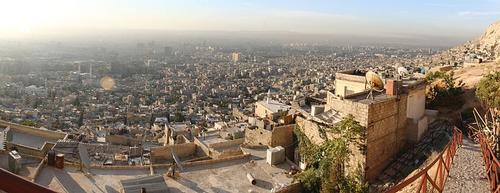 Damascus PanoramaPhoto: Wurzelgnohm in the public domain
Damascus PanoramaPhoto: Wurzelgnohm in the public domain
Damascus is the capital of Syria and is one of the country's 14 provinces. Damascus is governed by governors appointed by the Ministry of the Interior. The city is also one of the oldest continuously inhabited cities in the world, an important cultural and religious centre of the Near East.
Damascus is commonly known in Syria as Al Sham or the City of Jasmine. According to the 2009 census, the city has a population of 1,711,000. Damascus is the centre of a metropolitan area with an estimated population of 2.4 million. The metropolitan area includes the cities of Duma, Harasta, Darayya, Al-Tall and Jaramana.
Location
The coordinates of Damascus are: 33°30'47' north latitude and 36°17'31' east longitude. Damascus is located in southwestern Syria. The Barada River flows through Damascus. The city lies about 80 km (50 miles) inland from the Mediterranean Sea, sheltered by the Anti-Lebanon Mountains. Damascus is located on a plateau 680 metres above sea level. The city has an area of 105 km2. The old city of Damascus, surrounded by the city walls, is located on the southern bank of the shallow river Barada. In the past Damascus was surrounded by a large oasis, the Ghouta area, fed by the Barada River.
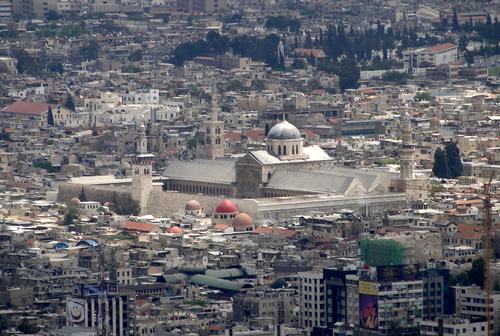 Damascus Old CityPhoto: Bernard Gagnon CC 3.0 Unported no changes made
Damascus Old CityPhoto: Bernard Gagnon CC 3.0 Unported no changes made
Weather
Damascus has a hot semi-desert climate, caused by the surrounding Anti-Lebanon Mountains. Summers are dry and hot with low humidity. Winters are mild and relatively rainy, sometimes with snowfall. The annual precipitation is about 288 mm. The average daily temperature is 24.6° C and the average night temperature is 10.5° C. The highest temperature measured in Damascus is 45° C and the lowest temperature is -6° C.
History
There are signs of human habitation in the Barada area dating back to 9000 BC. The first settlement on the site of present-day Damascus dates from the 2nd millennium BC.
From 661 to 750 BC Damascus was the capital of the Umayyad Caliphate. After victory by the Abbasid dynasty, the seat of Islamic power was moved to Baghdad. Damascus fell into disrepair during the Abbasid era, but regained its status during the periods of the Ayyubids and the Mamluks. During the Ottoman rule, the city declined again, but maintained a certain cultural prestige.
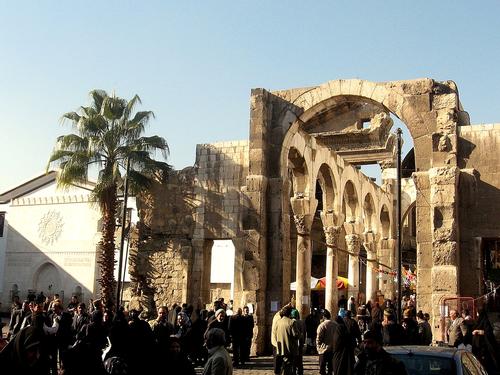 Roman Jupiter temple remains in DamascusPhoto: Ai@ce CC2.0 Generic no changes made
Roman Jupiter temple remains in DamascusPhoto: Ai@ce CC2.0 Generic no changes made
In 64 BC, the Roman general Pompey occupied the western part of Syria. The Romans conquered Damascus and the city became part of an alliance of ten cities known as the Decapolis. Damascus became a metropolis at the beginning of the 2nd century AD and was upgraded to a Roman Colonia by Emperor Septimius Severus. During the Pax Romana (the Roman Peace) Damascus and the Roman province of Syria in general experienced a period of prosperity. The importance of the city grew rapidly. Damascus became a stop along the caravan routes. The trade routes from South Arabia, Palmyra, Petra, and the silk routes from China all passed through the city. Damascus became the transit port for Eastern Roman luxury goods.
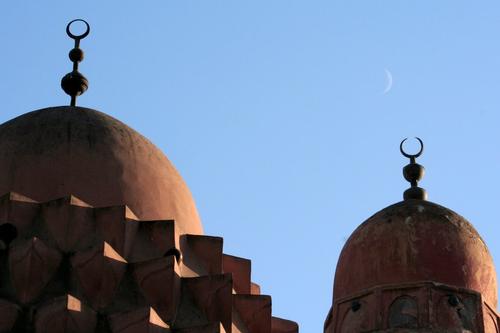 Tomb of Nur ad-DinPhoto: Tigr CC 2.0 Generic no changes made
Tomb of Nur ad-DinPhoto: Tigr CC 2.0 Generic no changes made
With the arrival of the Seljuk Turks in the late 11th century, Damascus once again became the capital, but its independence came to an end with the Mongol invasion in 1260. The Mongols were defeated in the same year and Damascus became a provincial capital of the Mameluk Empire until 1516. In 1516 the Ottomans conquered the Mameluk sultanate. The Ottoman Turks remained there for the next 400 years.
At the beginning of the 20th century, nationalist sentiment grew in Damascus, first from a strong cultural interest, but later increasingly politically inspired. The nationalist feeling grew especially after a number of patriotic intellectuals were hanged by the governor of Damascus. In 1918 when the fighters of the Arab revolt and the British army approached, the inhabitants attacked retreating Turkish troops. On 03 October 1918 the forces of the Arab revolt led by Prince Faysal entered Damascus. Faysal Ibn Hussein was proclaimed king of Syria.
On 02 June 1941 Damascus was occupied by Vichy-French troops. On 29 May 1945 the French were forced to withdraw. Syria became an independent state in 1946 with Damascus as its capital. Today it is the seat of the central government and all ministries and offices as well as foreign embassies. In 2008 Damascus was chosen as the Arab cultural capital.
Sights
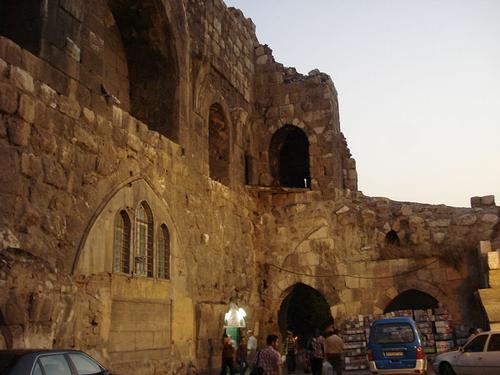 Citadel of DamascusPhoto: Aziz 1005 in the public domain
Citadel of DamascusPhoto: Aziz 1005 in the public domain
Damascus is a city full of historical sites dating back to many different periods of its history. The remains of the city's past are found in various layers of sites and ruins. Archaeological excavations take place 2.4 metres below the city level. Most tourist attractions can be seen in the old city, the core of Damascus. The Citadel of Damascus is located in the north-western corner of the Old City.
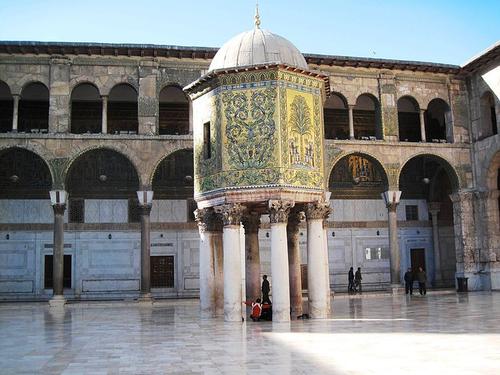 Umayyad Mosque in DamascusPhoto: Dickelbers CC 3.0 neet porteerd no changes made
Umayyad Mosque in DamascusPhoto: Dickelbers CC 3.0 neet porteerd no changes made
The Umayyad Mosque, also known as the Grand Mosque of Damascus, is one of the largest mosques in the world and also one of the oldest places of worship since the rise of Islam. It is believed that the body of St John the Baptist lies in a shrine in the Grand Mosque. Nearby is also the tomb of Saladin, the Muslim sultan of Egypt, Syria, Yemen and Palestine and founder of the Ayyubid dynasty. He is one of the most famous Muslim heroes and achieved great success in wars against the Christian crusaders. He conquered Jerusalem on 2 October 1187 and ended the almost nine-decade-long occupation by the Franks. His tomb is in the gardens outside the Great Mosque.
Inside the old city there are a number of beautiful Christian churches, such as the Chapel of Saint Paul, the House of Saint Ananias, the Mariamite Cathedral of Damascus, the Roman Catholic Cathedral in Zaitoon (Olive) and the Syrian Orthodox St. George's Church.
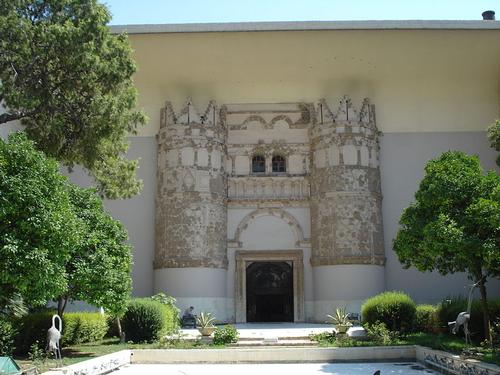 Damascus National MuseumPhoto: Public Domain
Damascus National MuseumPhoto: Public Domain
The Ministry of Culture has tried to combine elements of the city's heritage with contemporary developments. The prestigious Arabic Language Academy of Damascus, founded in1919 , is a bastion of the Arabic language and works to both preserve and modernise the language. The National Museum, founded in 1936, has an extraordinary collection of artefacts from all over the country. There are also other museums and cultural institutions that bring a large number of visitors to the city.
Tips
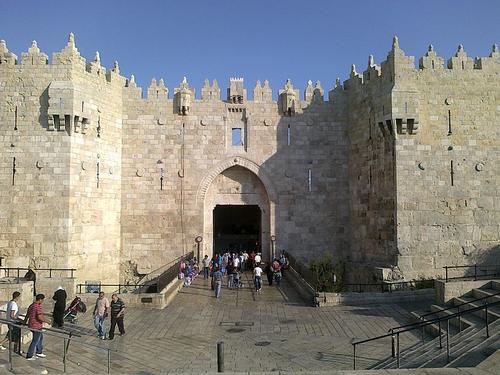 City gate DamascusPhoto: Biosketch CC 3.0 Unported no changes made
City gate DamascusPhoto: Biosketch CC 3.0 Unported no changes made
Be sure to visit the old city gates. The Old City of Damascus covers an area of about 128 hectares and is surrounded by ramparts on the northern and eastern sides and partly on the southern side. There are seven well-preserved city gates, the oldest of which date back to Roman times: Bab al-Saghir-the Small Gate, Bab al-Salam-the Gate of Peace, both located on the northern border of the Old City. Bab Tuma- The Thomas Gate, located in the north-east corner leading to the Christian Quarter of the same name. Bab Sharqi - The East Gate, lies in the eastern wall, the only one where the Roman structure can still be seen. Bab Kisan is the city gate in the south-east wall from which, according to legend, St Paul escaped from Damascus in a basket. The gate is now closed and a chapel has been built in memory of this event. Bab al-Jabiya is at the entrance to Souk Midhat Pasha, in the southwest.
Useful links Damascus
BBC Country ProfilesWorld Fact Book Explore all Countries
How to call
Last updated November 2025
Copyright: Team - The World of Info